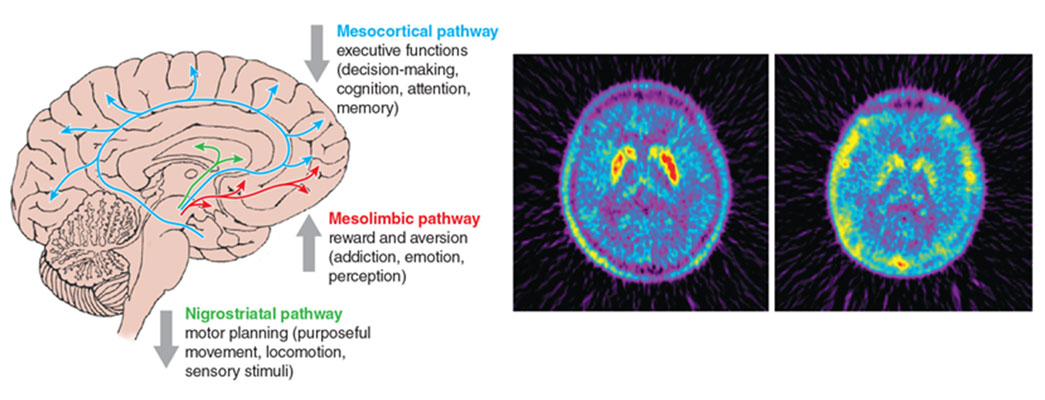What Parkinson's Reveals About the Artistic Spark
By Matthew Pelowski, Blanca T. M. Spee, Alby Richard, Paul Krack, Bastiaan R. Bloem
Neurological changes can activate the artistic brain.
Neurological changes can activate the artistic brain.

“I know that I am sick, and it is a horrible thing, but honestly I have never felt more artistic in my life.”
–Parkinson’s patient, personal correspondence with one of the authors
Parkinson’s disease is the fastest-growing neurological condition in the world, currently affecting around 0.1 percent of the population and rising to 3 percent of those over the age of 65. The list of well-known patients is long—from Muhammad Ali to Vincent Price, to, more recently, Michael J. Fox. Finding ways to ease the symptoms and improve the lives of people with Parkinson’s disease is a broad, urgent area of research. Along the way, the study of Parkinson’s patients is also having a remarkable, and rather unexpected, consequence: It may lead to new insights into the basis of the “artistic spark”—the neurobiology underlying the way we create and respond to art.
In case reports published during the past two decades, medical doctors have noted that their patients have an intriguing relationship with art. These case reports along with studies that we have conducted provide support for new theories about why and how Parkinson’s patients might experience an increased desire, and even ability, to create art.

Courtesy of exhibition catalog for Parkinson, Créativité, Dopamine from the Musee Grenoblois Des Sciences Medicales (doi: 10.7892/boris.144776)
Parkinson’s disease progressively impairs the brain’s ability to produce dopamine. Colloquially known as the “happiness hormone,” dopamine is in fact a major neurotransmitter that allows brain areas to communicate and thus to function normally. It is produced in deep-brain structures and distributed through several neuronal pathways, and it is essential for movement, behavior, mood, attention, learning, and reward-seeking behaviors.
Clinically, Parkinson’s and the dysfunction of dopamine pathways is associated with myriad symptoms, including problems with motor control—such as tremor, slowness, and difficulty walking—which is how the disease is typically diagnosed. Nonmotor symptoms include sleep disturbances, changes in vision or sense of smell, and cognitive difficulties, such as problems with planning or difficulty regulating emotion. (See “The Rise of Parkinson’s Disease,” May–June.) Parkinson’s disease progresses in stages, from mild motor symptoms on one side of the body in the first stage, to the inability to walk without support, and even hallucinations and delusions in later stages. However, symptoms can initially manifest as subtle perceptual or cognitive changes many years before diagnosis. Affected individuals typically live with Parkinson’s for many years, albeit with increasing disability.
Currently, the progression of Parkinson’s cannot be slowed, but symptomatic support can be achieved with, among other interventions, medications that replenish cerebral dopamine levels. Most treatments aim to increase dopamine signaling in the brain by increasing dopamine production via levodopa (the precursor of dopamine), and by stimulating receptors via dopamine agonists.
Parkinson’s and its treatments have yielded a serendipitous glimpse into the nature of creativity and the neurological complexity of creating art. It has become apparent, particularly since the 2000s, that a subset of individuals with Parkinson’s disease who are receiving medication to correct their dopamine deficiency experience a sudden and new awakening of artistic creativity and desire. A 2012 survey of several hundred Parkinson’s patients reported that up to 20 percent experienced an increased desire for creative endeavors such as making art. This spontaneous artistic desire is also documented in several medical case studies by doctors and in patient profiles on the Parkinson’s Foundation website, which until recently collected an archive of artworks and statements noting new artistic interest from patients, who in many cases had not previously shown any particular interest in art. Among established artists as well, there are notes of changed artistic motivation, style, and even (typically improved) quality of produced art.
This information about patients constitutes a treasure trove of data. Although most case studies have focused on visual art, similar interests in other forms of creative expression, such as music or poetry, have also been reported. Links between changes in art making and neurodegeneration are not unique to Parkinson’s. Patients with frontotemporal dementia and Alzheimer’s disease have also been reported to display sudden, newfound interest in creating art, and in more expressive, “looser” artistic techniques. But because of the distinct pattern and progression of changes to the brain in patients with Parkinson’s disease—and the relation to dopamine and the changes brought about by dopamine-boosting medication—it clearly indicates which brain regions to study and offers insight into the influence of these brain regions on artistic desire and creativity itself.
We recently collected all of the medical insights and supporting evidence together, with the goal of digging deeper. We reviewed the entire known collection of case histories and several other related theoretical discussions, focusing on visual art making and searching for consistent patterns related to individuals who displayed changed visual creativity and increased interest in producing art. By focusing on the neuropathology of Parkinson’s disease and its specific treatments, we have developed a theory as to what might be happening in the brain to produce such changes.
Artists who practiced before diagnosis with Parkinson’s disease have shown changes in the style or even the quality of their visual art.
In the case evidence, we found rather consistent support for a general increase in the desire to create art. Increased motivation was also routinely mixed with an increase in self-reported creativity, with patients noting that they felt freer and more spontaneous. Equally intriguing, we found that in most case studies of artists who practiced before being diagnosed with Parkinson’s, both the patients and their doctors reported an increase, or at least no decrease, in the quantity, and often the quality, of the art. We also found evidence, after patients were diagnosed and began dopamine therapy treatment, for a general movement from realism to abstraction or impressionism, more vibrant colors, and more use of crosshatching or lack of vertical or fluid strokes (perhaps due to cognitive symptoms or tremors).
Some patients even appear to develop addictive behavior, giving up sleep or food to make art, abusing their medication, or, in a notable case study, creating artwork on tables, walls, and even the washing machine. Some engaged in behaviors such as punding—prolonged, repetitive actions, such as cutting out and pasting newspaper clippings. We also found that the productive period for most case study artists is quite long. The time during which patients continued creating art ranged from 0 to 20 years after diagnosis, with a mean of about 11 years, at which point most artists were still very productive.
Perhaps most important, for almost all Parkinson’s patients who exhibited changes in artistic desire, we found that these changes occurred after diagnosis and after beginning treatment with dopamine replacement therapy. The drive to make art appeared to diminish when dopamine medication was stopped or taken at a lower dosage, or when the patient was treated with deep brain stimulation, a procedure in which electrodes are surgically inserted into the brain to alleviate Parkinsonian symptoms—and which often coincides with reducing or stopping dopaminergic medication. Most individuals who showed artistic change did so during the early stages of the disease, when their symptoms were rather mild and widespread damage likely had not yet occurred.
These bits of evidence come together when we relate them to dopamine and the neuroarchitecture of the brain. Three primary pathways regulate the brain’s dopamine expression. In individuals who experience artistic change, brain degeneration might be most prevalent in areas tied to motor control, which would explain why artistic change is typically an early manifestation of Parkinson’s disease. Motor control is regulated by the nigrostriatal pathway (specifically affecting the substantia nigra and dorsal striatum parts of the brain). Disruption in those areas unmasks motor symptoms, leading to a diagnosis of Parkinson’s, with subsequent initiation of dopaminergic medication, which will largely restore motor functions, at least temporarily.
At the same time, patients, especially in the early stages of disease, may still have relatively little damage in areas under the control of the other two dopamine-associated pathways: the mesocortical and especially the mesolimbic. The latter pathway is involved in regulating introspection, flexibility, associations, idea generation, motivation, reward seeking, and impulsiveness. When a patient starts taking Parkinson’s medication, the drugs (especially dopamine agonists) may cause increased (above baseline) activity in these undamaged regions, in a sense supercharging them and possibly increasing their effect on behavior and cognition. Stronger activation of these circuitries might lead to an increase in new associations, idea generation, and the rewards of art making, leading patients to become more engaged, more productive, and maybe even “better” artists.
The specific type of agonist medications found consistently in the pertinent case studies target D3 dopamine receptors, which are selectively expressed in the mesolimbic pathway. It is also possible that the subset of individuals who spontaneously begin making art may show preexisting genetic or structural features that make them more susceptible to dopaminergic medication in mesolimbic areas; or, this pathway may show some pattern of presymptomatic damage that makes it more responsive. We may also find selective dysfunction in areas linked with impulse inhibition and analytic self-judgment that are connected to the mesocortical dopamine pathway.
These findings offer intriguing clues about artists, and about the neurological act of making art. First, the evidence doesn’t just explain one or two specific areas or skills; rather, it points to the existence of a general network of functions and regions in the brain that is involved in creativity and making art. The collective body of evidence suggests that the brain circuitries involved in lowering inhibition and in heightening reward and reward-based learning, flexibility, association making, and executive thinking may hold the seed for visual creativity and artistic motivation.

Diagram by Barbara Aulicino; PET scans courtesy of CERMEP-Lyon, Professor Emmanuel Broussolle
This finding illustrates an important new way of thinking about the role of the brain in many human activities, moving away from a focus on single brain regions. Research in general neuroscience and Parkinson’s disease offers support here. Brain-imaging studies show that many of these same brain areas are involved when people engage in visual creative activities. These regions may even be more interconnected or denser in the brains of professional artists.
Our research on changes in patients with Parkinson’s also provides a glimpse into what sets artists apart. The importance of general attitude, spontaneity, and lowered inhibition—found here in Parkinson’s disease patients receiving dopamine-boosting medication—also suggests several main drivers of artistic success. We completed a study to evaluate how significant a role personality, perception, and physical ability play in creating a result that could be considered “art.” Participants created art from visual cues and copied images by hand, which were evaluated by judges. The participants also completed personality surveys, which were evaluated against standardized measures for personality and perception that have been shown to have correlations with skillful copiers and trained artists.
We found that, predominantly, personality and creativity assessments and the amount of time per day spent making art (thus reflecting motivation, not necessarily training) correlated with how successful the participants’ artwork was judged to be by expert artists. In contrast, aspects involving motor control or visual memory, which could play a role in the ability to copy what one sees, did not coincide with better art and may be secondary to motivation or creativity in explaining the artistic spark or what makes a work of art truly unique. The fact that many successful artists continue their careers after being diagnosed with Parkinson’s disease supports this idea.
Such evidence inspires further curiosity about the lives of artists and patients, as there is much we still do not know. For example, in a recent set of particularly compelling studies, one of the authors surveyed 750 Parkinson’s patients and 1,300 other people in the same age group about the jobs they had held throughout their lifetimes. They found that having had an artistic job earlier in life was not predictive of the onset of Parkinson’s. However, people who held artistic jobs later in life and were then diagnosed with Parkinson’s showed almost no symptoms. In other words, a higher innate inner drive to be visually creative or make art might be a natural defensive measure, diminishing the chance of developing neurodegeneration.
Decreased novelty-seeking behavior is a common Parkinson’s symptom, and in unmedicated patients it’s potentially related to diminishment in the pathways discussed previously. However, some patients upon beginning drug therapy experience a return or even a blossoming of interest in art. Although this effect could be interpreted to mean that the brain changes in Parkinson’s are related to a loss of creativity, an alternative explanation is that artists, by virtue of having had higher initial levels of cerebral dopamine, which stimulated their artistic behavior in the first place, are protected against their dopamine levels dropping below the critical threshold at which Parkinson’s disease becomes manifest.

Courtesy of Joaquim Ferreira (CNS - Campus Neurológico Sénior, Torres Vedras, Portugal)
In addition to stimulating the desire to create art, might dopamine-mediating medication also change how art is perceived? Recently, we explored this question for the first time in a small lab study of medicated Parkinson’s patients. To provide a rubric for symptom identification, the patients rated paintings using scales of liking and beauty as well as terms related to the artworks’ formal and conceptual qualities. Patients’ responses were also compared with those of age-matched healthy control participants. The patients with Parkinson’s were more likely to give the art a high rating for emotional expressiveness, perhaps because of the tie between dopamine expression and reward.
There’s a particularly interesting implication of this study. One of the most consistent, and surprising, findings was that there was very little difference between the two groups in their ratings of the likability or beauty of a painting: Their appraisals of beauty and art preferences were almost exactly the same between individuals with and without Parkinson’s disease. Similarly, individuals with stroke-related damage or with Alzheimer’s disease also show consistency in their ratings of art. For example, despite not remembering having previously participated in a study, when asked to rate the same art again, Alzheimer’s patients gave almost the same ratings as before. It may be that the aesthetic sense has so stable a foundation that it cannot even be touched by neurodegenerative disease, and appreciation of art and an increased desire to create it may be less interconnected than one might assume.
The intersection between changes associated with Parkinson’s and the changes in art making that we observed presents a new lens through which to understand the overlapping faculties used in creativity and art making: perception, memory, dexterity, and imagination.
Click "American Scientist" to access home page
American Scientist Comments and Discussion
To discuss our articles or comment on them, please share them and tag American Scientist on social media platforms. Here are links to our profiles on Twitter, Facebook, and LinkedIn.
If we re-share your post, we will moderate comments/discussion following our comments policy.